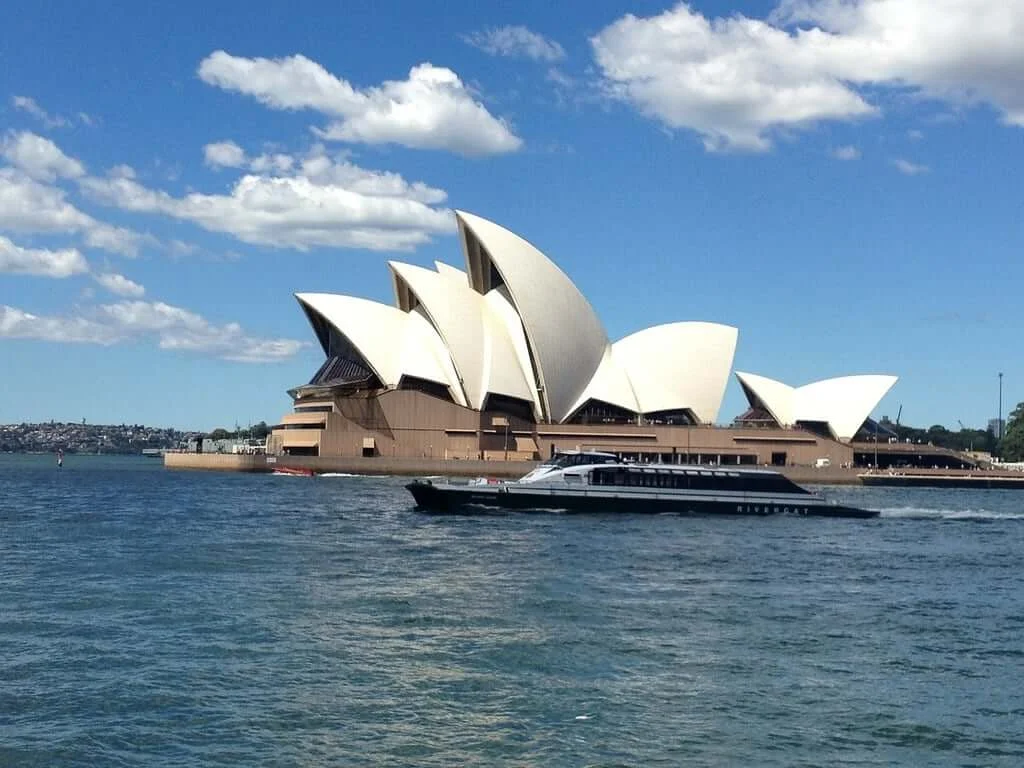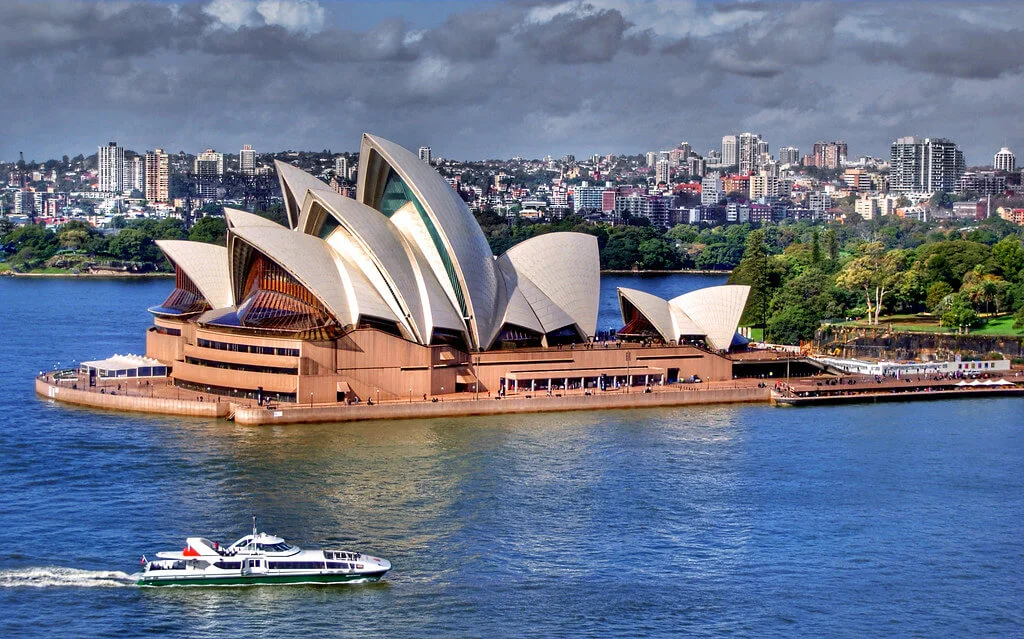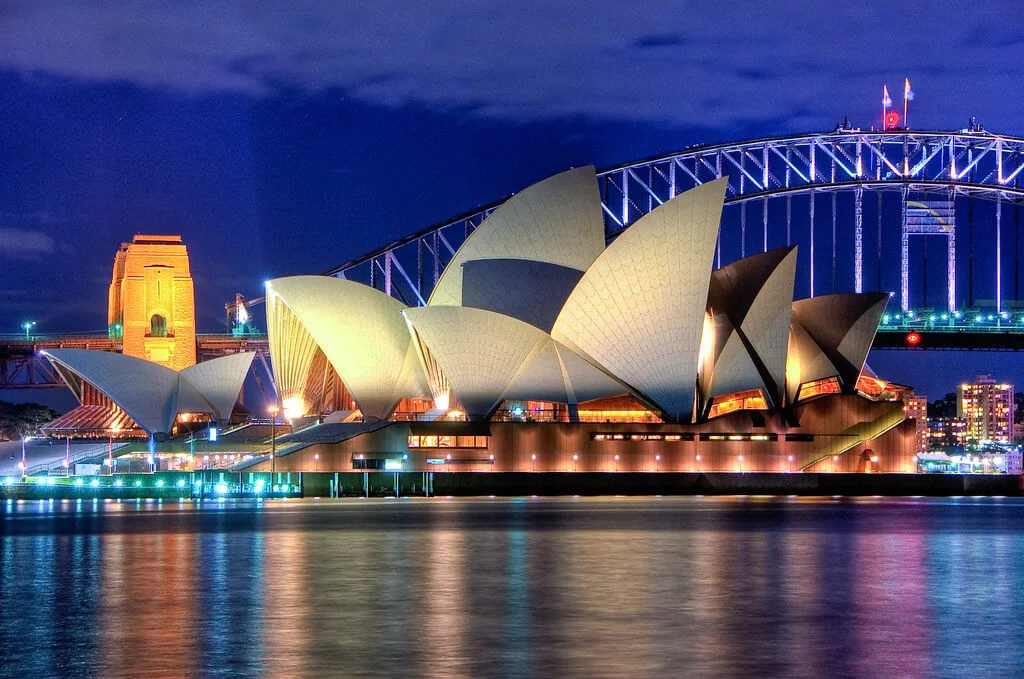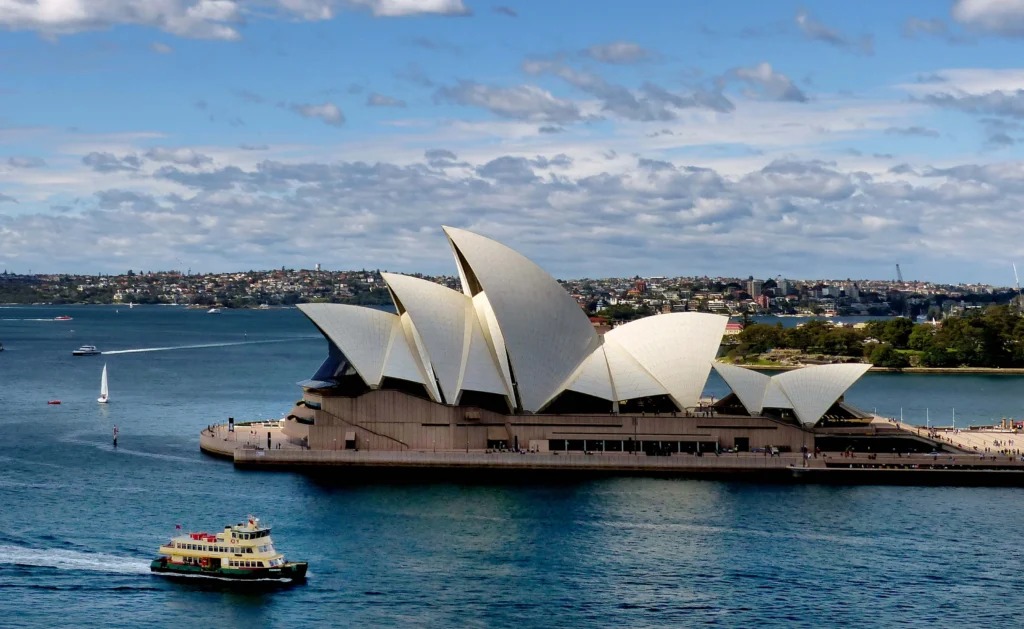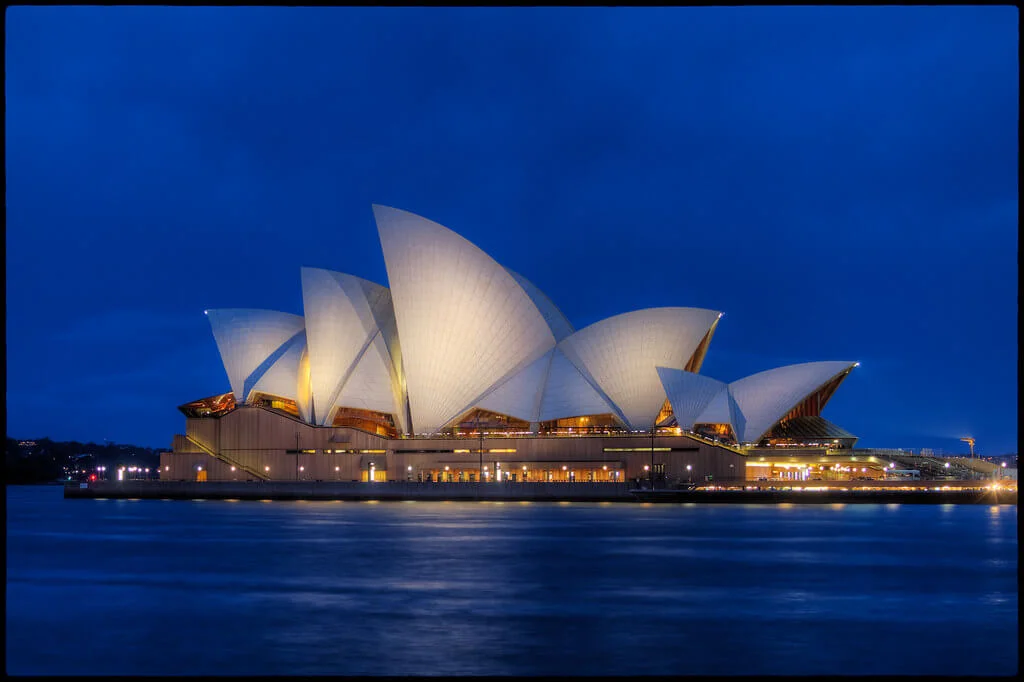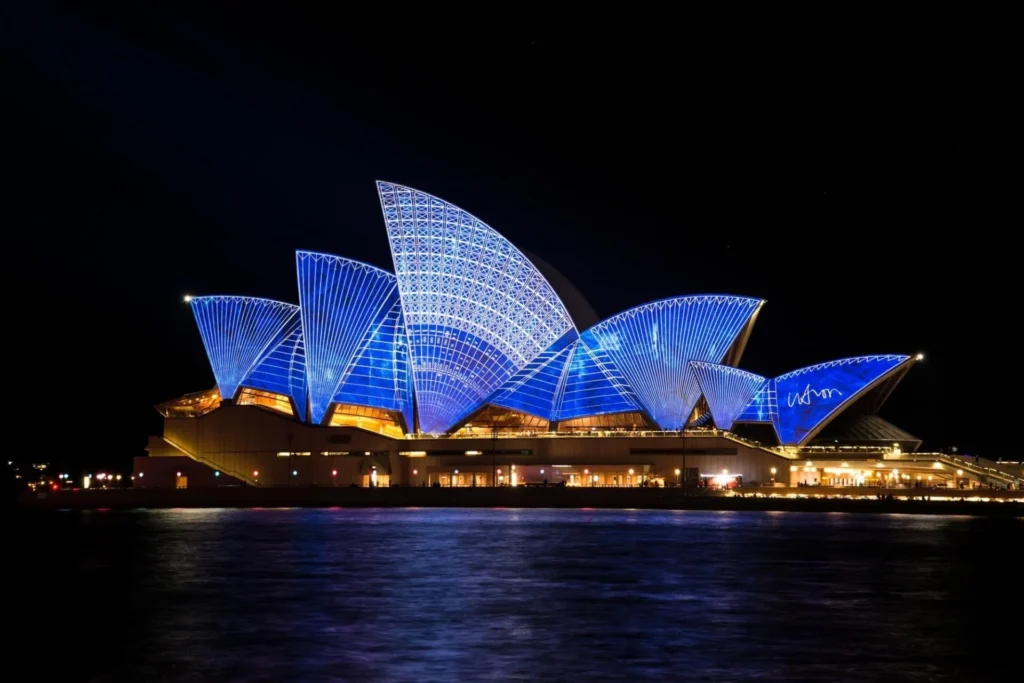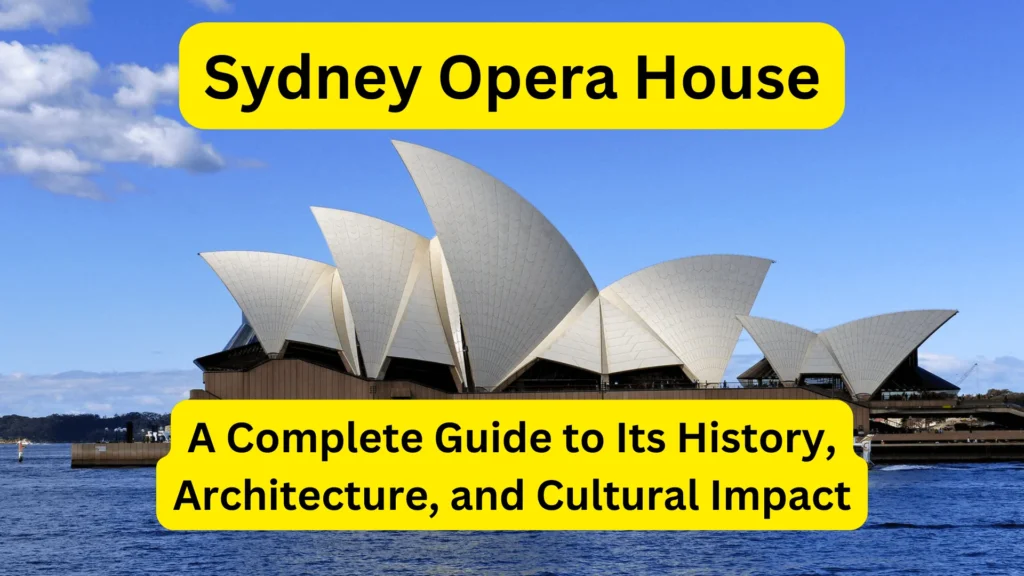
Introduction
Brief Overview of the Sydney Opera House
Location: Bennelong Point, Sydney, Australia
The Sydney Opera House is a masterpiece of modern architecture, majestically situated on Bennelong Point, a promontory in Sydney Harbour. This iconic location offers panoramic views of the Sydney Harbour Bridge, Circular Quay, and the city’s skyline, making it a centerpiece of Sydney’s urban landscape. Bennelong Point itself carries historical significance, named after Woollarawarre Bennelong, a senior Eora man who played a pivotal role in the early relations between Indigenous Australians and European settlers. The Opera House’s placement at this culturally rich site enhances its status as not just a building but a symbol of Australian history, bridging the past and present.
Status: UNESCO World Heritage Site, Architectural Marvel
Recognized as one of the most distinctive and famous buildings in the world, the Sydney Opera House was designated a UNESCO World Heritage Site in 2007. This prestigious status underscores its global significance as an extraordinary example of 20th-century architecture. The building is renowned for its innovative design, which features a series of white, sail-shaped shells that evoke the image of a ship at full sail, harmoniously blending with the maritime environment of Sydney Harbour.
Designed by Danish architect Jørn Utzon, the Opera House is celebrated not only for its aesthetic appeal but also for the bold engineering and technological advancements that were required to bring Utzon’s visionary design to life. The building’s unique structure, with its curved shells and complex geometry, pushed the boundaries of what was possible in architecture and construction at the time, marking it as a true architectural marvel.
Importance and Global Recognition
Symbol of Australia’s Cultural Identity
The Sydney Opera House has transcended its original purpose as a performing arts venue to become a powerful symbol of Australia’s cultural identity. It is more than just a building; it embodies the spirit of modern Australia, characterized by creativity, innovation, and a deep connection to the natural environment. The Opera House is an emblem of national pride, representing Australia on the world stage and serving as a cultural beacon that reflects the country’s rich artistic heritage. Its distinctive silhouette is instantly recognizable and is often used in international media to signify Australia, making it one of the most photographed buildings in the world.
Tourist Attraction Drawing Millions Annually
As one of the most visited tourist attractions in the world, the Sydney Opera House draws over 10 million visitors annually. Its appeal is universal, attracting not only architecture and art enthusiasts but also travelers from all walks of life who come to experience its grandeur. The Opera House provides guests with a wide range of experiences, such as informative guided tours that explore the building’s architectural and historical significance and a varied schedule of events that includes everything from modern theater and music to opera and ballet.
The surrounding precinct, with its scenic promenades, restaurants, and views, enhances the visitor experience, making a trip to the Sydney Opera House a must for anyone visiting Sydney. Its enduring allure as a tourist destination underscores its importance as a global cultural landmark and a testament to human ingenuity and artistic expression.
Historical Background
Early Concepts and Design Competition
The Inception of the Idea in the 1940s
The idea for what would eventually become the Sydney Opera House was conceived in the 1940s, a time when Sydney was growing rapidly and developing a thirst for cultural and artistic venues. The city lacked a dedicated space for large-scale performances, particularly for opera and symphonic music. Eugene Goossens, the then-director of the NSW State Conservatorium of Music, was one of the earliest and most vocal advocates for the creation of a grand venue that would put Sydney on the map as a center for the performing arts.
Goossens envisioned a world-class facility that would not only serve the needs of the local arts community but also attract international artists and productions. His persistent lobbying played a crucial role in gaining public and governmental support for the project, setting the stage for what would become one of the most ambitious architectural endeavors of the 20th century.
The International Design Competition in 1956
In 1956, the New South Wales government took a bold step by announcing an international design competition to create a world-class opera house at Bennelong Point. The competition was groundbreaking in its scope, attracting 233 entries from 32 countries, showcasing a wide array of architectural visions. The criteria for the competition were deliberately broad, allowing architects to submit innovative and unconventional designs without being constrained by rigid guidelines.
This openness to creativity led to a diverse range of submissions, from the traditional to the futuristic. The competition reflected the global post-war enthusiasm for modernist architecture, which sought to break free from the classical styles of the past and embrace new forms that could better express the spirit of the times.
Jørn Utzon’s Winning Design

Amidst the numerous submissions, Danish architect Jørn Utzon’s design stood out for its radical and imaginative approach. Utzon, who was relatively unknown at the time, proposed a design that featured a series of large, sail-like shells that would rise organically from the base of the building, resembling the billowing sails of a ship. His vision was both daring and poetic, capturing the essence of Sydney’s maritime environment while pushing the boundaries of architectural design.
The judging panel, led by the renowned architect Eero Saarinen, recognized the brilliance of Utzon’s concept, despite its technical complexities and the challenges it would present in construction. Utzon’s design was selected as the winner in 1957, marking the beginning of a long and arduous journey to bring his visionary concept to life. The decision to award the prize to Utzon’s design was a bold statement, signaling a willingness to embrace modernism and innovation in architecture.
Construction Challenges and Innovations
Groundbreaking in 1959
The official groundbreaking for the Sydney Opera House took place on March 2, 1959, with much fanfare and optimism. However, from the outset, it became clear that realizing Utzon’s design would not be straightforward. The platform, the roof shells, and the inner areas were the three phases of the project. Construction began with the podium, but even this seemingly simple structure posed significant challenges due to the site’s geology and the need for precision in laying the foundation for the complex roof structure that was to follow. Despite these early challenges, the groundbreaking symbolized the commitment of the New South Wales government and the people of Sydney to creating a landmark that would stand the test of time.
Architectural and Engineering Hurdles
The most formidable challenge in the construction of the Sydney Opera House was undoubtedly the realization of Utzon’s unique roof design. The complex geometry of the shell structure had never been attempted before, and there were no existing engineering solutions to guide the process. The design required the shells to be constructed in a way that would not only be aesthetically pleasing but also structurally sound.
To achieve this, Utzon and his team had to experiment with various construction methods, ultimately developing a solution that involved pre-casting segments of the shells in a factory and then assembling them on-site. This innovative approach allowed for greater precision and control, but it also led to significant delays and cost overruns as the team grappled with the technical difficulties. The challenges were compounded by the lack of advanced computer modeling tools, meaning much of the work had to be done manually and through trial and error. The engineering firm Ove Arup & Partners played a critical role in overcoming these challenges, working closely with Utzon to translate his vision into reality.
Final Completion in 1973
After years of setbacks, budget blowouts, and intense political scrutiny, the Sydney Opera House was finally completed in 1973. By this time, Jørn Utzon had resigned from the project in 1966 amid mounting pressure and disputes with the government over costs and design changes. The final stages of construction, including the completion of the interior spaces, were overseen by a team of Australian architects who made several modifications to Utzon’s original plans.
Despite these changes, the Opera House retained the essence of Utzon’s design, with its iconic shells and innovative structure. The building was officially opened by Queen Elizabeth II on October 20, 1973, in a grand ceremony that celebrated the achievement of this architectural and cultural milestone. The completion of the Sydney Opera House marked the end of a long and challenging journey, but it also heralded the beginning of its life as one of the most celebrated and recognizable buildings in the world.
Architectural Significance
Unique Design Elements
The Iconic Sail-Like Shells
The most distinctive feature of the Sydney Opera House is its sail-like shells, which have become an enduring symbol of both the building and the city of Sydney itself. These shells, which appear to billow in the wind like sails on Sydney Harbour, are composed of a series of precast concrete segments that form a series of overlapping shells. Each shell is made up of ribs and panels, creating a complex yet harmonious structure that gives the building its iconic silhouette.
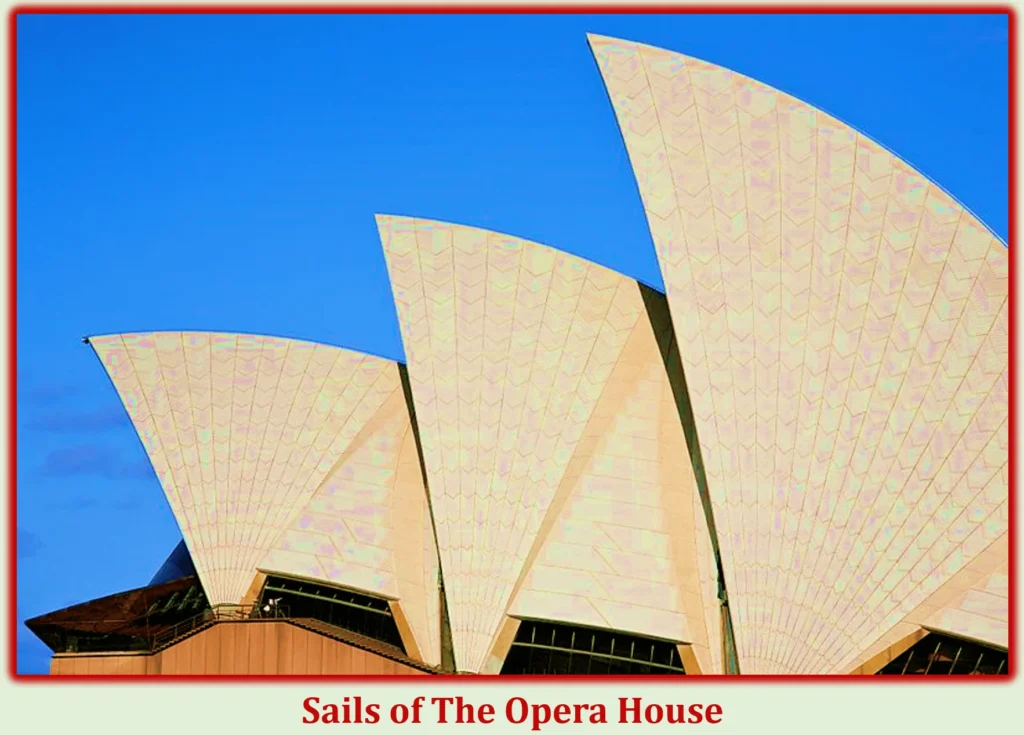
The design was inspired by various natural forms, including the segments of an orange and the wings of a bird, reflecting architect Jørn Utzon’s deep connection with organic shapes and his desire to create a building that was in harmony with its surroundings. The sail-like shells not only define the Opera House’s exterior but also play a crucial role in its functionality. Their shape allows for a unique interplay of light and shadow, creating dynamic visual effects throughout the day. At night, the shells are often illuminated, further enhancing their dramatic appearance.
The visual impact of the shells is complemented by their symbolic resonance, representing both the maritime heritage of Sydney and the Opera House’s role as a beacon of culture and creativity. The daring and unconventional nature of the design challenged traditional architectural norms, making the Sydney Opera House a landmark of modern architecture.
Fusion of Modernist and Expressionist Architecture
The Sydney Opera House is a masterpiece of modernist and expressionist architecture, blending these two styles to create a building that is both functional and deeply symbolic. Modernist architecture, characterized by simplicity, clean lines, and a focus on function, is evident in the building’s overall form and the use of new construction techniques and materials. The Opera House’s design rejects historical architectural styles in favor of an innovative approach that reflects the technological and artistic advancements of the 20th century.
At the same time, the building exhibits key elements of expressionist architecture, a style that emphasizes emotional experience and organic forms. Expressionism in architecture often involves dynamic shapes, unconventional angles, and a focus on creating a sense of movement, all of which are present in the Sydney Opera House. The building’s dramatic forms and fluid lines express a sense of freedom and creativity, evoking an emotional response from those who view it. This fusion of styles results in a structure that is not only a functional space for the performing arts but also a work of art in its own right, capable of inspiring and moving those who encounter it.
Structural Engineering Feats
Use of Precast Concrete Sections
One of the most significant engineering innovations of the Sydney Opera House is the use of precast concrete sections to construct its sail-like shells. The complexity of the shells’ design required a construction method that could provide both strength and precision, leading to the development of a groundbreaking approach involving precast segments. These segments were manufactured off-site in a specially built facility, where they could be produced under controlled conditions to ensure their accuracy and quality. Once cast, the segments were transported to the construction site and assembled with meticulous care.
The use of precast concrete allowed for a level of precision that would have been difficult to achieve with traditional construction methods. It also enabled the construction of the shells to proceed more quickly and efficiently, despite the technical challenges involved. This approach was not without its difficulties, as the sheer scale and complexity of the shells required the development of new techniques and equipment for handling and assembling the segments. However, the successful implementation of this method was a testament to the ingenuity and determination of the engineers and construction teams involved, setting a new standard for architectural and engineering excellence.
Innovative Design Solutions for the Roof Structure
The roof structure of the Sydney Opera House posed one of the greatest challenges in its construction, requiring innovative solutions that pushed the boundaries of architectural engineering. The shells are supported by a system of interlocking arches, which distribute the enormous weight of the structure evenly across the building’s foundation. This system was a significant engineering achievement, as it allowed the shells to rise to their full height without the need for internal supports, which would have compromised the open, airy feel of the performance spaces below.
To address the challenges of constructing such a complex roof, the engineering team, led by Ove Arup & Partners, developed several pioneering techniques. One of the key innovations was the use of a three-dimensional mathematical model to calculate the precise curvature and structural integrity of the shells. This model, one of the first of its kind, allowed engineers to predict how the shells would behave under various conditions and to design the supporting arches accordingly. The result was a roof structure that was both incredibly strong and visually stunning, perfectly complementing the building’s overall design.
Interior Design and Acoustics
The Performance Halls: Concert Hall, Opera Theatre, etc.

The interior of the Sydney Opera House is as remarkable as its exterior, with a series of performance halls that are designed to provide world-class acoustics and an unparalleled experience for audiences. The largest of these is the Concert Hall, which can seat over 2,000 people and is renowned for its acoustical brilliance. The hall’s interior is lined with wood, which not only enhances its warm, inviting aesthetic but also contributes to its exceptional sound quality. The seating is arranged in a fan shape, ensuring that every member of the audience has a clear view of the stage and can enjoy the full impact of the performances.

The Opera Theatre, now known as the Joan Sutherland Theatre, is another key venue within the Opera House. It is designed specifically for opera and ballet performances, with a seating capacity of around 1,500. The theatre’s design incorporates a deep stage, an orchestra pit, and advanced technical facilities to accommodate the complex needs of large-scale productions. The intimate yet grand atmosphere of the theatre makes it a favorite among performers and audiences alike.
In addition to these main venues, the Opera House also includes the Drama Theatre, the Playhouse, and the Studio, each designed for different types of performances. These spaces are more intimate, allowing for a closer connection between the performers and the audience. The variety of venues within the Opera House reflects its role as a versatile cultural center, capable of hosting a wide range of events, from classical music concerts to contemporary theatre and dance.
Acoustic Engineering Tailored for Performances
One of the most critical aspects of the Sydney Opera House’s design is its acoustic engineering, which was tailored specifically to ensure that the performance spaces offer the best possible sound quality. Achieving this was particularly challenging due to the unique shape and materials of the building. The acoustics of each performance hall were carefully calibrated to suit the specific needs of the events held there, from symphonic concerts to operas and theatrical performances.
In the Concert Hall, for example, the acoustics were designed to enhance the richness and clarity of the music, allowing every note to be heard with precision. This was achieved through the careful selection of materials, the shape of the hall, and the placement of acoustic reflectors that help to distribute sound evenly throughout the space. The hall’s high ceiling and large volume also contribute to its excellent acoustics, creating a reverberant yet clear sound that is ideal for orchestral performances.
The Opera Theatre’s acoustics were optimized for vocal performances, with a focus on ensuring that the singers’ voices could be heard clearly over the orchestra. The design of the theatre, including the size and shape of the stage and the configuration of the seating, was all carefully planned to create an acoustical environment that supports the unique demands of opera.
The success of the acoustic engineering in the Sydney Opera House is a testament to the collaboration between architects, engineers, and acousticians, who worked together to create spaces that not only look stunning but also sound incredible. The result is a building that is as much a triumph of acoustical design as it is of architecture, providing audiences with an experience that is both visually and aurally unforgettable.
Cultural Impact
Role as a Performing Arts Center
Home to the Sydney Symphony Orchestra, Opera Australia, etc.
The Sydney Opera House is more than just an architectural marvel; it is a vibrant hub of the performing arts, serving as the home for some of Australia’s most prestigious cultural institutions. Among these, the Sydney Symphony Orchestra (SSO) stands out as one of the oldest and most respected orchestras in the country. The SSO regularly performs in the Concert Hall, bringing both classical and contemporary music to life with its world-class musicianship. The orchestra’s performances draw audiences from around the globe, contributing to the Opera House’s reputation as a leading venue for orchestral music.
In addition to the SSO, Opera Australia, the nation’s premier opera company, also calls the Sydney Opera House home. The company stages productions in the Joan Sutherland Theatre, offering audiences the chance to experience both traditional and modern operatic works in a setting that enhances the drama and spectacle of the performances. Opera Australia’s presence at the Opera House helps to maintain the venue’s status as a key player in the international opera scene, attracting renowned performers and directors from around the world.
Beyond these flagship companies, the Opera House also hosts the Australian Ballet, the Sydney Theatre Company, and numerous other performing arts organizations. This diverse range of resident companies ensures that the Opera House is constantly alive with a variety of performances, from ballet and theatre to contemporary dance and experimental art forms. The Opera House’s role as a performing arts center is thus integral to Sydney’s cultural landscape, providing a space where the best of Australia’s artistic talent can be showcased alongside international productions.
Host to Over 1,500 Performances Annually
The Sydney Opera House is one of the busiest performing arts centers in the world, hosting over 1,500 performances annually across its various venues. This staggering number of events highlights the Opera House’s role as a cornerstone of Sydney’s cultural life, offering something for everyone, from classical music lovers to fans of cutting-edge contemporary performances. The diversity of the programming ensures that the Opera House remains accessible to a broad audience, with performances ranging from grand opera and symphony concerts to small-scale theatre productions and experimental art installations.
The Opera House’s extensive calendar of events also includes numerous festivals, special events, and one-off performances by international artists. These events often draw large crowds, further cementing the Opera House’s reputation as a global cultural destination. The sheer volume and variety of performances make the Opera House a dynamic and ever-evolving space, where audiences can experience a wide range of artistic expressions. This continuous flow of events keeps the Opera House at the forefront of the performing arts world, ensuring that it remains relevant and engaging for both local and international audiences.
Influence on Global Arts and Culture
Platform for International Artists and Events
The Sydney Opera House has long been a magnet for international artists and events, serving as a prestigious platform where global talent meets Australian audiences. From world-renowned musicians and orchestras to leading theatre companies and dance troupes, the Opera House has played host to some of the most significant names in the arts. International theater groups like the Royal Shakespeare Company and the National Theatre of Great Britain have staged breakthrough works alongside performances by luminaries like Luciano Pavarotti, Elton John, and the Berlin Philharmonic.
The Opera House’s ability to attract such high-caliber artists and events is a testament to its status as one of the world’s foremost cultural venues. Its global reach has made it a key player in the international arts scene, where it is recognized not only for its architectural significance but also for its commitment to excellence in the performing arts. By providing a platform for international artists, the Opera House fosters cultural exchange and brings global perspectives to Australian audiences, enriching the cultural fabric of the country.
Moreover, the Opera House is a regular host of major international events, including festivals, award ceremonies, and world premieres. These events often receive extensive media coverage, further enhancing the Opera House’s international profile and highlighting its role as a beacon of global culture. The presence of international artists and events at the Opera House contributes to its standing as a symbol of cultural excellence and a vital link between Australia and the rest of the world.
Representation of Australian Art and Culture on the World Stage
While the Sydney Opera House is a global cultural icon, it is also a vital representative of Australian art and culture on the world stage. The Opera House provides a platform for Australian artists to showcase their work to international audiences, whether through performances, exhibitions, or festivals. This exposure helps to promote Australian culture globally, highlighting the country’s artistic achievements and its contributions to the world’s cultural landscape.
The Opera House’s role in promoting Australian culture is evident in its support for Indigenous artists and performers. It regularly hosts events and performances that celebrate Australia’s First Nations cultures, offering a space where Indigenous stories, music, and art can be shared with a global audience. This commitment to Indigenous culture is an essential part of the Opera House’s identity, reflecting Australia’s diverse cultural heritage and its ongoing efforts to honor and preserve the traditions of its First Peoples.
In addition to supporting Indigenous art, the Opera House is also a key venue for contemporary Australian artists across various disciplines, from music and theatre to visual arts and dance. By providing a high-profile stage for Australian talent, the Opera House plays a crucial role in shaping the country’s cultural identity and ensuring that Australian voices are heard on the world stage. This influence extends beyond the performances themselves, as the Opera House’s iconic status helps to elevate Australian culture in the global imagination, positioning Sydney as a leading cultural capital.
Sydney Opera House Today
Renovations and Modern Adaptations
Ongoing Maintenance and Modernization Projects
The Sydney Opera House, while a masterpiece of 20th-century architecture, requires continuous care to preserve its iconic status and ensure it meets the needs of contemporary audiences. Since its completion in 1973, the Opera House has undergone numerous renovations and modernization projects to address the wear and tear of time, as well as to update its facilities in line with modern standards.
One of the most significant recent projects is the decade-long Renewal Program, launched in 2013. This ambitious initiative, with a budget exceeding AUD 275 million, aims to upgrade the Opera House’s infrastructure, improve accessibility, and enhance the experience for both performers and visitors. Key components of the Renewal Program include the refurbishment of the Joan Sutherland Theatre, improvements to the Concert Hall, and upgrades to the Opera House’s acoustics, staging, and backstage facilities. These renovations are designed to preserve the building’s historical integrity while integrating state-of-the-art technology, ensuring that the Opera House remains a world-class venue for the performing arts.
The Opera House is also making strides in enhancing accessibility. Recent upgrades include new elevators, ramps, and accessible seating, making it easier for all visitors to navigate and enjoy the spaces within the building. The introduction of new digital technologies, such as advanced lighting and sound systems, further ensures that the Opera House can accommodate the technical demands of modern productions, maintaining its status as a cutting-edge cultural venue.
Sustainability Initiatives
In addition to its architectural and technological upgrades, the Sydney Opera House is committed to sustainability, recognizing the importance of minimizing its environmental impact. As one of the most visited landmarks in the world, the Opera House is acutely aware of its responsibility to lead by example in the area of environmental stewardship.
One of the Opera House’s key sustainability initiatives is its commitment to achieving carbon neutrality. In 2018, it became the first cultural institution in the world to achieve carbon-neutral certification from the Australian government. This milestone was the result of extensive efforts to reduce energy consumption, increase recycling, and offset remaining emissions. The Opera House has installed energy-efficient lighting and HVAC systems, introduced water-saving measures, and implemented a comprehensive recycling program that includes composting organic waste from its restaurants and cafes.
The Opera House has also embraced sustainable building practices in its renovations, using eco-friendly materials and methods wherever possible. The building’s maintenance and construction projects are guided by the principles of the Green Building Council of Australia, ensuring that sustainability is at the forefront of all improvements. These efforts are part of a broader commitment to environmental sustainability, positioning the Sydney Opera House as a leader in the global movement toward greener, more sustainable cultural institutions.
Visitor Experience
Tours, Exhibitions, and Interactive Experiences
The Sydney Opera House is not only a venue for world-class performances but also a destination in its own right, offering a wide range of experiences for visitors. Guided tours of the Opera House provide a behind-the-scenes look at this iconic building, taking visitors through its grand interiors, performance halls, and backstage areas. These tours are designed to be both informative and immersive, offering insights into the history, architecture, and cultural significance of the Opera House. Specialized tours, such as the Backstage Tour and the Indigenous Cultural Tour, offer unique perspectives on the building and its role in Australian culture.
In addition to tours, the Opera House hosts various exhibitions and interactive experiences throughout the year. These exhibitions often explore the history and design of the Opera House, as well as its impact on the arts and culture in Australia and beyond. Interactive installations and digital displays allow visitors to engage with the Opera House in new and innovative ways, making the experience both educational and entertaining.
The Opera House also offers a range of family-friendly activities, ensuring that visitors of all ages can enjoy their time at this cultural landmark. From workshops and performances tailored to younger audiences to interactive displays that allow children to learn about the arts, the Opera House is a place where culture and education come together. These offerings make the Sydney Opera House a must-visit destination for tourists and locals alike, providing a rich and varied experience that goes beyond its world-renowned performances.
Hotels Near Sydney Opera House
When visiting the Sydney Opera House, staying in nearby accommodations can enhance your experience, offering convenient access to this iconic landmark as well as breathtaking views of Sydney Harbour. Here’s a guide to some of the best hotels in the vicinity, each offering unique features and amenities to suit various preferences and budgets.
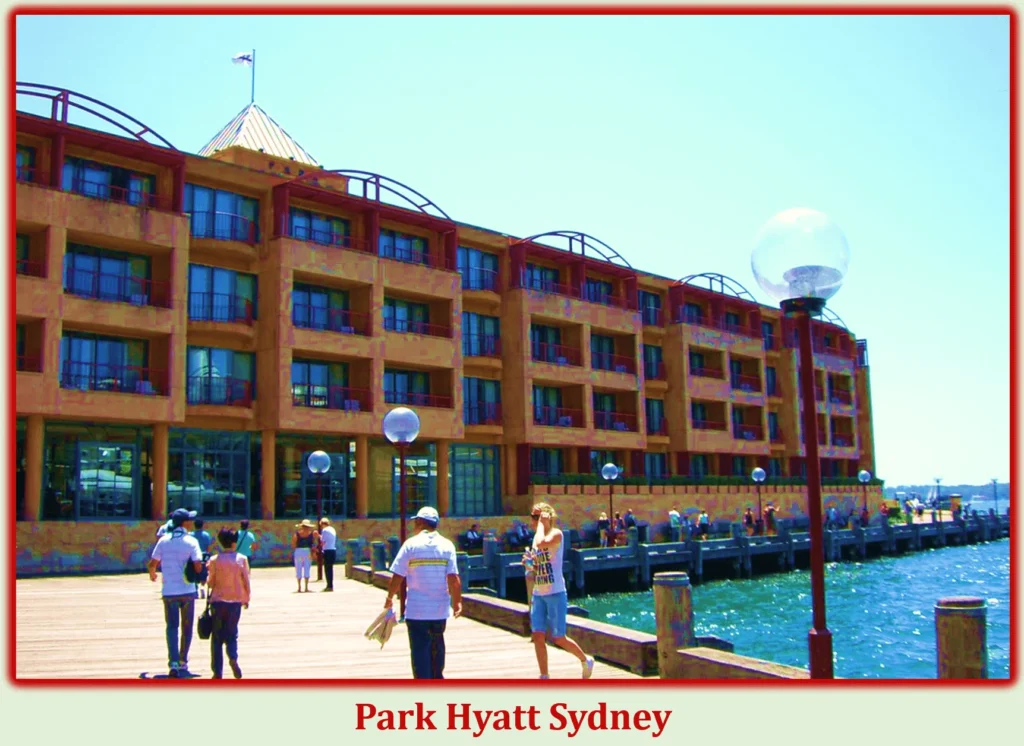
- Park Hyatt Sydney
- Overview: Park Hyatt Sydney is a luxurious five-star hotel located just a short stroll from the Opera House. Known for its elegant design and exceptional service, it offers stunning views of Sydney Harbour and the Opera House from many of its rooms.
- Features
- Views: Panoramic views of the Opera House and Sydney Harbour.
- Amenities: Spa, fitness center, rooftop pool, and gourmet dining options.
- Experience: Renowned for its refined atmosphere and personalized service, making it a top choice for those seeking a high-end stay.
- The Langham, Sydney
- Overview: The Langham, Sydney is another premium option offering luxury and comfort close to the Opera House. This five-star hotel blends contemporary conveniences with traditional grandeur.
- Features
- Views: Some rooms offer views of the harbour and city skyline.
- Amenities: Spa, indoor pool, fine dining restaurant, and a well-equipped fitness center.
- Experience: Known for its sophisticated decor and exceptional hospitality, perfect for both leisure and business travelers.
- InterContinental Sydney
- Overview: Located in the historic Treasury Building, the InterContinental Sydney offers a blend of heritage charm and contemporary luxury, making it a great choice for visitors to the Opera House.
- Features
- Views: Harbour view rooms and suites are available.
- Amenities: Indoor pool, spa, dining options, and a club lounge.
- Experience: Combines historical elegance with modern amenities, providing a comfortable and stylish stay.
- Shangri-La Sydney
- Overview: Situated a bit further but still within a short distance from the Opera House, Shangri-La Sydney offers a luxurious experience with some of the best views of the city’s skyline and harbour.
- Features
- Views: Many rooms offer breathtaking views of Sydney Harbour and the Opera House.
- Amenities: Spa, fitness center, indoor pool, and a variety of dining options.
- Experience: Renowned for its high level of service and luxury, ideal for those seeking a top-tier hotel experience.
- Hilton Sydney
- Overview: Hilton Sydney is centrally located and offers easy access to the Opera House as well as other key attractions in Sydney. It provides modern comforts and convenient amenities.
- Features:
- Views: Some rooms offer views of the city skyline.
- Amenities: Fitness center, indoor pool, and a range of dining options.
- Experience: Offers reliable comfort and service with the advantage of being close to major shopping and dining areas.
- The Russell Hotel
- Overview: For those seeking a more budget-friendly option with character, The Russell Hotel provides a charming and affordable stay close to the Opera House.
- Features
- Views: Limited views but centrally located for easy access to the Opera House.
- Amenities: Basic amenities including free Wi-Fi and breakfast.
- Experience: Offers a cozy, boutique experience with a focus on personalized service and charm.
Staying at one of these hotels near the Sydney Opera House not only provides convenience but also enhances your overall experience with proximity to one of Sydney’s most iconic landmarks. Whether you’re looking for luxury, comfort, or affordability, these options cater to a range of preferences, ensuring a memorable stay in one of the world’s most vibrant cities.
Sydney Opera House in Popular Culture
Appearances in Films, TV, and Media
Featured in Iconic Movies and TV Shows
The Sydney Opera House, with its unique architectural design and breathtaking location on the shores of Sydney Harbour, has become one of the most recognizable landmarks in the world. As such, it has featured prominently in numerous films, television shows, and other media, solidifying its status as an iconic symbol of both Australia and modern architecture.
In cinema, the Opera House has appeared in a wide range of genres, from action-packed blockbusters to heartfelt dramas. One of the most famous appearances is in the 1996 film Independence Day, where the Opera House is dramatically destroyed during an alien invasion, highlighting its global recognition and cultural significance. The landmark has also been featured in films like Mission: Impossible II (2000), where its striking silhouette serves as a backdrop to high-octane action scenes, and Finding Nemo (2003), where the animated version of the Opera House plays a key role in the plot, introducing it to a younger generation.
Television has also capitalized on the Opera House’s iconic status. It frequently appears in establishing shots and scenes meant to depict Sydney, often symbolizing the city itself. The Opera House has been showcased in popular TV series such as The Simpsons, where it’s humorously portrayed, and Modern Family, which featured it during the family’s trip to Australia. These appearances have helped to cement the Opera House’s image as a quintessential representation of Sydney and Australia on the global stage.
Symbol in Advertising and Branding
The Sydney Opera House’s distinctive design has made it a powerful symbol in advertising and branding. Its image is often used to convey ideas of sophistication, culture, and prestige, making it an ideal choice for marketing campaigns both in Australia and internationally. The Opera House is frequently featured in advertisements for travel and tourism, where it serves as a shorthand for Sydney and, by extension, the entire country of Australia. Images of the Opera House are used to evoke a sense of adventure and cultural richness, enticing potential visitors with the promise of experiencing one of the world’s most famous landmarks.
Beyond tourism, the Opera House has been utilized in branding for a wide range of products and services, from luxury goods to global corporations. Its iconic silhouette has appeared in advertisements for airlines, luxury watches, and even financial services, where it is used to suggest reliability, timelessness, and innovation. The Opera House’s ability to convey such powerful and positive connotations has made it an enduring element in global branding efforts.
In addition to commercial uses, the Opera House has also become a symbol of national pride in Australia. It is regularly featured in public service campaigns, government promotional materials, and other initiatives aimed at fostering a sense of cultural identity and unity. The use of the Opera House in these contexts underscores its importance not just as a building, but as a symbol of what Australia represents to the world.
Cultural References and Artworks
Inspiration for Artists, Writers, and Musicians
The Sydney Opera House has not only influenced the realms of film and television but has also served as a profound source of inspiration for artists, writers, and musicians across the globe. Its iconic design, coupled with its cultural significance, has made it a muse for countless creative works that explore themes of modernity, beauty, and the intersection of nature and human achievement.
In visual arts, the Opera House has been depicted in various styles, from hyper-realistic paintings to abstract interpretations. Artists are drawn to the building’s flowing, organic lines and the way it interacts with its natural surroundings, creating a dynamic interplay of form and light. The Opera House has been the subject of numerous exhibitions and has even inspired a range of artworks that reimagine its structure in different contexts, reflecting the versatility and enduring appeal of its design.
Writers, too, have found inspiration in the Opera House. It has been featured in numerous novels, poems, and essays, often symbolizing the pinnacle of human creativity and ambition. The building’s creation story, with its trials, triumphs, and eventual completion, is frequently cited as a metaphor for artistic perseverance and vision. In literature, the Opera House is often portrayed as a character in its own right, embodying the spirit of Sydney and the aspirations of the people who brought it to life.
Musicians have also been influenced by the Opera House, both in terms of its acoustical qualities and its symbolic significance. Many composers and performers have created works specifically for the venue, taking advantage of its unique acoustic properties to create music that resonates with both the space and the audience. The Opera House has inspired pieces that celebrate its architectural beauty, its role in the cultural life of Sydney, and its place in the broader narrative of artistic achievement.
Subject of Documentaries and Books
The Sydney Opera House has been the focus of numerous documentaries and books that explore its architectural significance, cultural impact, and the human stories behind its creation. These works provide in-depth looks at the Opera House, delving into the complexities of its design and construction, as well as the social and political contexts that shaped its development.
Documentaries such as The House (1997) offer a detailed chronicle of the Opera House’s history, from Jørn Utzon’s visionary design to the challenges faced during construction and the eventual completion of the project. These films often feature interviews with architects, engineers, and artists who were involved in the project, providing firsthand insights into the triumphs and tribulations that marked the Opera House’s journey. Through these documentaries, viewers gain a deeper appreciation of the Opera House not just as a building, but as a living symbol of creativity and perseverance.
Books on the Sydney Opera House are equally abundant, ranging from detailed architectural studies to historical accounts and personal memoirs. Titles like Jørn Utzon: The Man & The Architect by Richard Weston and The Saga of the Sydney Opera House by Peter Murray offer comprehensive explorations of the Opera House’s creation, capturing the drama and innovation that defined its construction. These books often include rare photographs, sketches, and other archival materials, making them invaluable resources for anyone interested in the history and significance of the Opera House.
Moreover, the Opera House continues to be a popular subject for academic studies and scholarly articles, which analyze its impact on architecture, urban planning, and cultural heritage. These works contribute to the ongoing discourse about the Opera House’s place in global culture, ensuring that its legacy is examined and celebrated from multiple perspectives.
Conclusion & FAQs
The Sydney Opera House stands as one of the most significant architectural achievements of the 20th century. Its contribution to architecture is unparalleled, embodying the fusion of modernist and expressionist styles in a way that has influenced generations of architects and designers. Jørn Utzon’s visionary design, with its sail-like shells, pushed the boundaries of what was thought possible in architectural form and engineering, setting a new standard for innovation in public building design.
Culturally, the Sydney Opera House has played a pivotal role in shaping Australia’s national identity. As a hub for the performing arts, it has hosted a diverse range of cultural expressions, from grand operas and symphonies to contemporary dance and indigenous performances. The Opera House has not only elevated the global profile of Australian arts but also provided a platform for international artists to engage with local audiences, fostering a rich exchange of cultural ideas.
In the arts, the Sydney Opera House has been a beacon of creativity. Its stages have seen performances by some of the most celebrated artists in the world, across various disciplines. The Opera House’s ability to adapt to different artistic needs—be it for orchestras, theater productions, or experimental performances—demonstrates its versatility and enduring relevance in the global arts scene.
The Sydney Opera House is more than just a building; it is a symbol of what human ingenuity and creativity can achieve. From its inception in the 1940s to its completion in 1973, the Opera House’s journey was marked by challenges that required innovative solutions. Utzon’s design was a bold departure from conventional architecture, and its realization involved overcoming significant technical and engineering obstacles.
Today, the Opera House continues to inspire innovation. It serves as a reminder that creativity often requires taking risks and venturing into the unknown. Its presence on the Sydney skyline is a testament to the power of vision and determination, embodying the idea that great art and architecture can transcend time, continuing to inspire future generations long after their creation.
As we move further into the 21st century, the Sydney Opera House remains as relevant today as it was when it first opened its doors. The ongoing Renewal Program and other modernization efforts ensure that the Opera House can meet the demands of contemporary audiences while preserving its architectural integrity. The introduction of cutting-edge technology and sustainability practices aligns the Opera House with the global shift towards more environmentally conscious and technologically integrated public spaces.
Moreover, the Opera House’s programming continues to evolve, reflecting the changing cultural landscape. By embracing diverse art forms and catering to a wide range of audiences, the Opera House ensures its continued relevance as a cultural institution. Whether through traditional performances, innovative digital experiences, or community engagement initiatives, the Opera House remains at the forefront of the global arts and culture scene.
Looking ahead, the Sydney Opera House is committed to preserving its legacy while also enriching its cultural offerings. The focus on sustainability and accessibility is central to its future, ensuring that the Opera House remains a welcoming space for all visitors and continues to minimize its environmental footprint.
Plans for further cultural enrichment include expanding its educational programs, deepening its engagement with indigenous cultures, and exploring new ways to integrate digital technology into the visitor experience. These initiatives aim to enhance the Opera House’s role as a center for learning and creativity, offering new opportunities for audiences to connect with the arts in meaningful ways.
As it approaches its centennial in the coming decades, the Sydney Opera House will likely continue to evolve, both as a physical space and as a symbol of artistic and architectural achievement. Its legacy as an enduring icon of innovation and creativity will be preserved and celebrated, ensuring that it remains a source of inspiration for generations to come.
Frequently Asked Question (FAQs)
Why is the Sydney Opera House considering an architectural marvel?
The Sydney Opera House is considered an architectural marvel because of its unique and innovative design, which features sail-like shells that challenge conventional architectural norms. Designed by Danish architect Jørn Utzon, the building pushed the boundaries of engineering and construction techniques, making it a symbol of modernist architecture and creative ingenuity.
How has the Sydney Opera House influenced global arts and culture?
The Sydney Opera House has influenced global arts and culture by serving as a premier venue for a wide range of performances, from classical music to contemporary art. It has hosted internationally renowned artists and events, contributing to the global cultural dialogue and elevating Australia’s profile in the arts.
What are the major challenges faced during the construction of the Sydney Opera House?
The major challenges faced during the construction of the Sydney Opera House included the complex geometry of its design, particularly the roof structure, and the need for innovative engineering solutions. The project also faced delays and budget overruns, but these were overcome through determination and creative problem-solving.
How does the Sydney Opera House contribute to sustainability?
The Sydney Opera House contributes to sustainability through its commitment to reducing its environmental impact. It has achieved carbon-neutral certification, implemented energy-efficient systems, and embraced sustainable building practices. These efforts ensure that the Opera House remains environmentally responsible while continuing to serve as a cultural landmark.
What are the future plans for the Sydney Opera House?
Future plans for the Sydney Opera House include ongoing renovations and modernization projects to maintain its status as a world-class venue. There are also initiatives to enhance its cultural offerings, such as expanding educational programs and integrating digital technology into visitor experiences, all while preserving its historical and architectural significance.
Can you visit the Sydney Opera House today?
Yes, visitors can tour the Sydney Opera House today. The Opera House offers guided tours that provide insights into its history, architecture, and cultural significance. Visitors can also attend performances, exhibitions, and other events, making it a vibrant and accessible destination for both locals and tourists.

